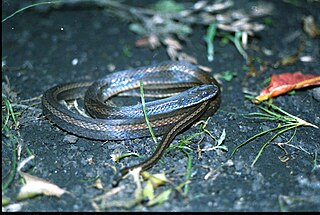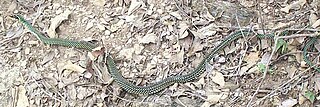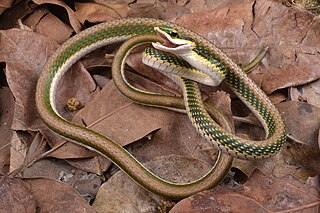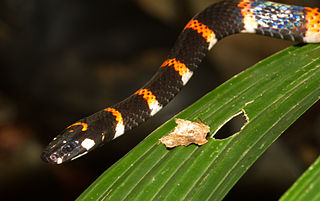
Boa is a genus of boas found in Mexico, the Caribbean, and Central and South America. Five extant species, and one extinct, are currently recognized.

Terciopelo is a species of pit viper found at low to moderate elevations in northeast Mexico and Central America, and into South America where it is known from elevations up to 2600 meters in the Colombian and Ecuadorian Andes, as well as into Venezuela. With a mass of up to 6 kilograms (13 lb) and a maximal length of 2.5 metres (8.2 ft), the terciopelo is among the largest pit vipers. It is light to dark brown in color, often with yellow zig-zag-shaped lines on each side of the body. Dubbed "the ultimate pit-viper" for its large size, fangs and venom yield, it has a fearsome reputation, responsible for the most snakebites within its range because of its defensive temperament and proximity to human residence. However, like other venomous snakes, it avoids confrontation with humans whenever possible. No subspecies are currently recognized.

Tantilla is a large genus of harmless New World snakes in the family Colubridae. The genus includes 66 species, which are commonly known as centipede snakes, blackhead snakes, and flathead snakes.

Oxybelis fulgidus, commonly known as the green vine snake or the flatbread snake, is a species of long, slender, arboreal colubrid snake, which is endemic to Central America and northern South America.

Coniophanes is a genus of colubrid snakes, commonly referred to as black-striped snakes, but they also have many other common names. The genus consists of 17 species, and despite the common name, not all of them display striping.

Drymobius is a genus of colubrid snakes commonly referred to as neotropical racers, which are endemic to the Americas. There are four species recognized in the genus.

Drymobius margaritiferus, commonly known as the speckled racer, is a species of nonvenomous colubrid snake native to the Americas. The specific name, margaritiferus, means "pearl-bearing" in Latin, referring to the pearl-like spots on the dorsal scales.

Bothriechis nigroviridis is a venomous pit viper species found in the mountains of Costa Rica and Panama. No subspecies are currently recognized. The specific name is derived from the Latin niger (black) and viridis (green) in reference to its distinctive color pattern.
Agkistrodon howardgloydi is a species of venomous snake, a pit viper (Crotalinae), that is endemic to Central America. It is most commonly called castellana,but it has also been called the southern cantil, Gloyd's moccasin, and a number of other colloquial names. It is a rare species with a relatively small geographic distribution in the tropical dry forest on the Pacific coast of Honduras, Nicaragua, and extreme northwest Costa Rica. Agkistrodon howardgloydi is a stout, medium-sized snake with a maximum length of 96 cm. It is a viviparous species, with female giving birth in the rainy season from May to August. No clinical reports on envenomation had been published, but laboratory texts and analysis indicate the venom is highly toxic and similar to its close relative Agkistrodon bilineatus, and potentially lethal.

Lachesis stenophrys, commonly called the Central American bushmaster, is a venomous pit viper species endemic to Central America.

Leptophis mexicanus, commonly known as the Mexican parrot snake, is a species of medium-sized slender snake in the family Colubridae. The species is endemic to the Americas.

Epictia goudotii, or the black blind snake, is a species of snake in the family Leptotyphlopidae. The species is endemic to Middle America.
The rustyhead snake, also known commonly as the rufous-headed snake, is a species of snake in the family Colubridae. The species is endemic to Central America and Colombia.

Leptodrymus is a genus of snake in the family Colubridae that contains the sole species Leptodrymus pulcherrimus. It is known as the striped lowland snake or green-headed racer.

Pliocercus euryzonus, commonly known as Cope's false coral snake, is a species of snake in the subfamily Dipsadinae of the family Colubridae. The species is indigenous to southeastern Central America and northwestern South America. There are two recognized subspecies.
Dunn's road guarder is a species of snake in the family Colubridae. The species is monotypic in the genus Crisantophis. It is endemic to Central America.
The Colombian longtail snake, also known commonly as the sock-headed snake and the white-headed snake, is a species of snake in the family Colubridae. The species, which is monotypic in the genus Enuliophis, is native to Central America and northern South America.

Stenorrhina degenhardtii, also known by its common name Degenhardt's scorpion-eating snake, is a species of snake in the family Colubridae. The species is native to southeastern Mexico, Central America, and northwestern South America. There are three recognized subspecies.

Drymobius chloroticus, the green highland racer, is a species of non-venomous snake in the family Colubridae. The species is found in Mexico, Belize, Honduras, Guatemala, El Salvador, and Nicaragua.

















